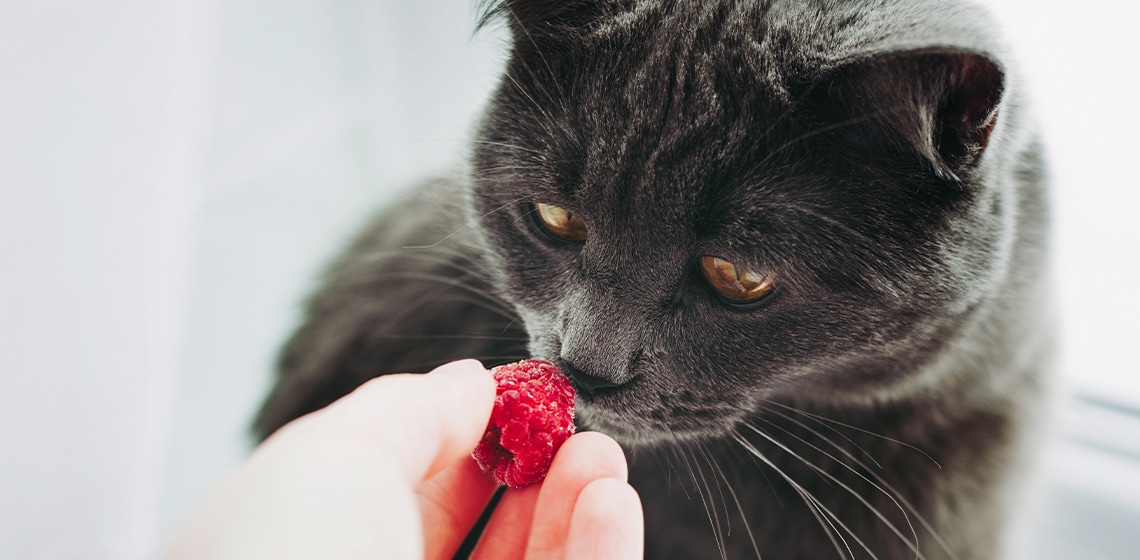Table of Contents
With summer coming, it’s the time of year for enjoying fresh berries like raspberries, blueberries, and strawberries. Whether it’s a healthy snack, part of a refreshing dessert, or to complement a summery cocktail, we humans love berries! But what about cats? Can cats eat raspberries? Is it safe?
Can cats eat raspberries?
Raspberries are quite a healthy snack for humans, full of vitamins, minerals, and antioxidants. So, can cats get these benefits too? Well, the answer is yes; cats can eat raspberries as they’re non-toxic. However, to keep your kitty healthy, there are a few guidelines to follow. If you want to find out which other fruits are safe for your furry friend, follow this link.
Cats can eat raspberries as they’re non-toxic.
What are the benefits of raspberries for cats?
Raspberries, as well as many other berries, are a great source of dietary fiber. Fiber is vital for keeping your furry friend’s gut healthy and ensuring they pass normal stools. Raspberries also contain antioxidants, vitamins, and minerals, including Vitamins A, C, E, and K, calcium, and potassium.
It’s not just what raspberries contain that makes them beneficial; it’s also what they don’t contain, namely fat. Being so low in fat and reasonably low in calories means they’re not as bad for your four-legged friend as naughty treats like cheese. Since obesity can lead to many health problems like diabetes and arthritis pain, it’s easy to see why a low-calorie, low-fat treat is better.
Being so low in fat and reasonably low in calories means they’re not as bad for your four-legged friend as naughty treats like cheese.
Are there any risks from feeding your cat raspberries?
Although raspberries aren’t very high in calories compared to some foods, they contain some natural sugars. We all know too much sugar in our diet isn’t good for our teeth or our waistline, and cats are no different! Another related risk is due to the high level of the natural sweetener, xylitol, in raspberries, which can be toxic in large amounts.
Feeding your cat any new food or too much of a particular food could cause them a stomach upset, and if they have a gut sensitivity, raspberries may not be a good choice. Raspberries can also have traces of chemicals like pesticides and herbicides on them unless they’re organic, and these could cause your cat to become unwell.
The final risk, which is true of any extra treats or titbits you might feed your cat, is the risk of disrupting the balance of your cat’s nutrition. Cats are obligate carnivores, meaning the majority of their diet should be animal-based protein. It’s also true that the mainstay of your feline friend’s diet should be their nutritionally complete and balanced cat food. If you feed too many treats, you could accidentally cause your pet a nutritional deficiency.
How can you avoid the risks of feeding your cat raspberries?
If you decide to feed your pussycat some raspberries, you should make sure you wash them first to remove any traces of nasty chemicals. Of course, if you’re really worried about added chemicals, you could choose organic raspberries.
To avoid giving your cat symptoms like vomiting, diarrhea, or wind, you should start by feeding them a tiny taste of raspberry to see if they can tolerate it. If, after a few days, they have no unpleasant symptoms, you can increase the amount slightly. Don’t overdo it, though – to avoid the risks from xylitol, your cat should only have small amounts of raspberry.
If you decide to feed your pussycat some raspberries, you should make sure you wash them first to remove any traces of nasty chemicals.
How many raspberries can a cat eat?
Once you know that your cat can tolerate a tiny piece of a raspberry without it upsetting their belly, you can safely give a little more. However, you shouldn’t give more than one or two whole raspberries per portion.
How often can a cat eat raspberries?
To avoid disrupting your cat’s nutrition, you shouldn’t offer them raspberries too often. Offering a small amount once a week is more than enough and will prevent the risks associated with the sugar and sweeteners within raspberries.
Summary
We all want what’s best for our furry family members, and nutrition is really important. It’s good to remember, though, that although nutritious foods like fruits and vegetables are good for humans, the best thing you can do for your cat’s health is to feed them balanced and complete cat food. Some little extras, like raspberries, are safe if given occasionally. Still, you should always check with your veterinarian before offering something new.
FAQ
If you’re considering feeding your cat a little bit of your raspberry, you can rest assured that it shouldn’t cause any problems. While small amounts of raspberry are not toxic to cats, you should be careful not to feed them too much or too often as it could me them unwell. Before feeding your cat raspberries for the first time, you should offer a small amount, the size of your little fingernail, to see if they develop vomiting or diarrhea. If they don’t, you’re safe to offer them a little more next time. It’s best not to offer more than two raspberries at a time and no more frequently than once a week.
Toxic foods for cats include chocolate, raisins, grapes, garlic, and onions, and you can find more information here. You should also stop them from having access to chewing gum or anything else that contains the artificial sweetener xylitol. However, it’s essential to check with your veterinarian before feeding your cat something if you’re not sure whether it’s safe for them. It’s not just food that can be toxic to cats either; follow this link to find out which plants are poisonous to cats.

Rebecca is a companion animal vet who has always had a passion for writing and client communication. Since her graduation from the Royal Veterinary college in 2009, she has gained a wealth of experience in first opinion small animal practice, in both clinical and managerial roles. She currently works in the South West and deals with a variety of routine and emergency appointments, but particularly enjoys medicine cases. Outside of work and writing, she enjoys spending time with her family, including her bouncy flat-coated retriever George!








